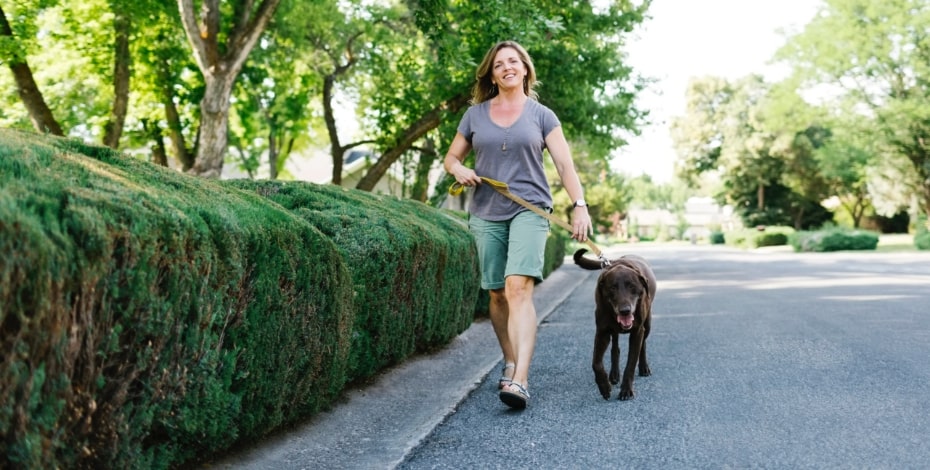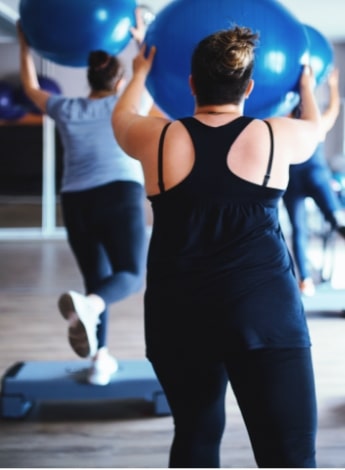
Let's get physical

Physiotherapists are in a unique position to promote increased physical activity to their clients. We speak to four physiotherapists about the importance of physical activity and how to talk about it.
It’s a sad truth that the vast majority of Australians are not physically active.
Studies by the Australian Institute of Health and Welfare show that more than half of all adults in Australia don’t meet the guidelines of 150–300 minutes of moderate to vigorous intensity activity per week and the numbers are even worse in children (AIHW 2020).
It’s a serious problem because insufficient physical activity is a significant risk factor for a range of chronic diseases, including diabetes, cancer, dementia, coronary heart disease and stroke.
‘Physical activity is almost like a magic pill. It helps with so many different health conditions,’ says Professor Steven McPhail, Professor of Health Services Research at Queensland University of Technology.

Steven McPhail says the benefits of increasing physical activity are often underestimated.
Steven says that as a public health intervention, increasing physical activity is often underestimated.
A 2018 report by the Australian Institute of Health and Welfare (AIHW 2021) estimated that 2.5 per cent of the disease burden in Australia is attributable to physical inactivity, with the cost of treating conditions associated with physical inactivity conservatively estimated to be $968 million in 2018–19 (AIHW 2022).
‘It is absolutely of critical importance to Australian society that we try to help people be appropriately physically active,’ Steven says.
Steven is a member of Physiotherapists for Physical Activity, a group convened in 2016 to share information and help physiotherapists promote physical activity to their clients across a range of clinical populations.
Dr Breanne Kunstler APAM, a physiotherapist, a researcher at Monash University’s BehaviourWorks and a co-convenor of Physiotherapists for Physical Activity, says that the group brings together physiotherapists and academics from many different clinical specialities to tackle issues associated with promoting physical activity.
The aim of the group, she says, is to provide practical and useful strategies for physiotherapists to help all clients to be physically active in ways that suit their needs.
Physiotherapists for Physical Activity is also an advisory group to the APA, helping with physical activity submissions and advocacy projects.
Why should physios promote physical activity to clients?
‘From a physio’s point of view, we think about why physical activity is important to the outcomes for the client,’ says Breanne.
‘Thinking about how physical activity can help people to manage or prevent chronic conditions is something that should be in a physio’s mind, particularly for middle-aged to older adults.
'We can also use it in our rehabilitation.
'Physical activity isn’t just about exercising and huffing and puffing or going for a five-kilometre run; it’s about participating in life.’
Steven says physiotherapists are in a unique position to promote physical activity to their clients.
‘Physiotherapists are experts in prescribing exercise and they’re also experts in knowing what physical activity people can and should do for their relative health state,’ he says.
Steven says that it’s often injuries preventing adults from playing sport or exercising, particularly as they move into middle and later life.
‘They stop playing that social game of football or getting out and jogging or walking the dog as much or catching up with friends while they walk around the park or shopping centre.
'These are things that physiotherapists are actually excellent at helping people to overcome.
'So physiotherapists have a special responsibility to help our clients, who may have difficulty with movement for one reason or another,’ he says.
Associate Professor Nicole Freene, from the University of Canberra and a member of Physiotherapists for Physical Activity, examines the effects of physical activity and sedentary behaviour on healthy adults and cardiac clients.
She says that although physiotherapists should be aware of the importance of physical activity, many are not.
‘I have done a bit of work on how many of us [physiotherapists] are promoting physical activity and how many of us know the physical activity guidelines and it’s really quite low.
'About 10 to 15 per cent of us know the guidelines.
'And you would expect more because we do call ourselves exercise specialists,’ Nicole says.
One issue, says Nicole, is that moderate to vigorous physical activity is different for everyone.
For someone who has limited mobility, for example, walking to their mailbox might count as vigorous activity.
‘I think some of us struggle with that.
'They go, “Well, they’re just walking to their mailbox.”
'And you go, “But if they’ve never left their house, and they’re struggling to walk from room to room, that’s a big deal for those guys,”’ she explains.
Nicole says it’s important to look at all the ways people can be physically active, particularly if they are resistant to the idea of exercise.
In fact, the word ‘exercise’ can turn some people off altogether.
‘Some people have never exercised in their life and when you start talking to them about exercising, they shut down.
'They don’t want to listen because it doesn’t interest them.
'Whereas when you talk about physical activity—which is any bodily movement other than sitting or lying down—and you talk about housework or gardening or dancing with friends, it’s a very different conversation,’ she says.

There are many different ways people can be physically active that might not seem like exercise.
Breanne agrees with Nicole and says that often people don’t even realise that what they are doing—such as taking the dog for a walk around the block or walking the kids to the park or even vacuuming the floors—is part of their daily physical activity.
‘We’ve got to be very clear with the client or person in front of us about what physical activity actually is and how it’s different from exercise and sport,’ she says.
It’s also important to avoid scaring clients with how much physical activity they need to be doing.
'Thirty minutes of physical activity five days a week can be difficult to factor in around work, commuting and family.
'Current thinking is that short bursts of moderate to vigorous intensity physical activity across the day and week are just as effective as longer sessions.
‘There are so many benefits to being physically active enough.
'And by enough, I mean meeting the physical activity guidelines, so that 150 to 300 moderate or 75 to 150 vigorous or a combination of both across the week.
'But in the same breath, you have to say, “Anything is better than nothing.”
'We know that.
'As soon as people start moving, they get the benefits,’ Nicole says.
The importance of communication
Communicating with the client is the first step in improving their physical activity levels, says Breanne.
And it starts with the very first conversation, whether they are coming in for an injury or to help manage a chronic condition.
‘Simply ask, “Do you regularly go for a walk?” or “What sort of exercise do you do? Do you participate in a sport?”
'General, basic questions that you might ask anyone about exercise would be completely appropriate,’ Breanne says.
It is important to realise that not all clients will know what physical activity means and how much they need to be doing, she says.

Breanne Kunstler says communication is a crucial first step in promoting physical activity to clients.
Talking to the client about their daily activities builds up a picture of how active they are and where they could incorporate increased physical activity.
‘An understanding of the person’s context, their social history, would give you many clues as to how physically active they are before you even ask the question,’ says Breanne.
However, you might only have 20–30 minutes with your client, every couple of weeks or even months.
It takes time to build up a rapport so that more in-depth conversations can be held.
‘Often these conversations need to occur over several sessions.
'When someone walks into your consultation room, you don’t get them straight on the table and start manipulating for 20 minutes.
'You typically have a conversation with them first.
'Each of those conversations will last a few minutes and it’s in those few minutes that you can ask a simple question such as “How was your week?” or “What are the kids up to?”’ says Breanne.
She recommends building on those questions from session to session, especially if the client is resistant to changing their behaviour.
‘Some people are not going to take your advice… it doesn’t matter what you do, how much knowledge you have, they’re just not going to take it on because they’re not ready to hear it and act on it and that’s okay.
'You can’t make people do things,’ says Nicole.
Ultimately, it’s the client’s choice, she says, and it can take them a while to work through the barriers preventing them from thinking about it.
‘You need to work with your client rather than telling them what to do.
'Then you’re more likely to see changes—it’s more likely that they’ll sort it out themselves and become more physically active and possibly adhere to it over the longer term,’ Nicole says.
Steven says physiotherapists may need to address the client’s fears about increasing their physical activity, especially if they have heart issues or other chronic conditions.
‘There may be a misperception that being physically active will make their condition worse.
'Physiotherapists are very good at talking with clients about the appropriateness of physical activity and thinking about how it best fits in their life, taking into account the likely benefits and other concurrent health conditions,’ he says.
In the end, Steven says, any physical activity is likely to be better than none and even low intensity exercise can yield excellent results.
Eight practical tips for talking to your clients about physical activity
1. Work together to set goals
Ask your client open-ended questions about their current physical activity and what they’d like to be doing.
‘Obviously they’re coming to you because they’ve got a problem.
'That can start the conversation of “Okay, you’ve got knee pain, do you do any activity?” or “What does your day consist of?” and we can find out what they enjoy doing to work out where more physical activity could fit in their day,’ says Shae Martello, a physiotherapist and member of Physiotherapists for Physical Activity based in Albury, New South Wales.
2. Start small and build up
‘It’s important to start small and build their confidence if they’re someone who isn’t very active,’ says Shae.
She suggests that starting could be as simple as setting a reminder on their phone to get up and move around regularly during the day, or walking down to the shops for a small amount of groceries instead of driving.
3. Make it easy
Identify times and ways your client can fit more physical activity into their daily routine.
Breanne uses the acronym EAST to remember the key facilitators for increasing physical activity:
- easy—is it something easy to fit into the daily routine around work and family life?
- attractive—is it something they will enjoy?
- social—is it something everyone else is doing?
- timeliness—is there a life event that will motivate them to exercise?
4. Be aware of what’s out there

Physiotherapists can work with clients to find out what they enjoy doing and to look for opportunities in their local neighbourhoods.
Know what opportunities for physical activity are available, such as local sports and recreation groups, fitness classes, National Disability Insurance Scheme-accessible programs and walking trails.
There are numerous exercise programs available online for people who are reluctant or unable to join group classes.
Shae says she keeps her eye out for local flyers and other resources, such as walking trail booklets.
‘I have new clients who have said, “I used to love doing ballroom dancing [before moving to Albury]” and I’ve passed on information on the local ballroom dancing group or rock-and-roll group, putting them in contact with those community groups,’ says Shae.
‘This is also helpful for building social connections and having support around them to encourage healthy behaviour change.’
5. Moderate versus vigorous exercise
It’s important for clients to understand the difference between moderate and vigorous exercise.
‘The thing I use [to explain] moderate intensity to clients is “You should be able to talk but not sing”.
'If you can sing, you’re not working hard enough and that’s an easy thing for people to test.
'Vigorous intensity is when they can’t talk in full sentences; that’s when they hit their anaerobic threshold.
'The talk test, I think, is a really good way of explaining to people.
'They seem to get that,’ says Nicole.
6. Make them accountable
Follow up with clients to see if they are increasing their physical activity, just as you might track a rehab exercise program.
Find out what works for the client—for example, using an app like PhysiApp or a wearable monitor like a Fitbit, recording in a notebook or using a printed checklist of exercises.
‘It depends on their age and their choice of engagement.
'We use PhysiApp for clients who are a bit more tech savvy—you can see exactly what they’ve been doing.
'I have other clients who like to write in a notebook or put my stick-figure exercise sheets on their fridge,’ says Shae.
7. Don’t push the issue
Sometimes clients are just not willing to have a conversation about increasing physical activity.
When this happens, it’s best to back off, but don’t stop trying to bring it up.
When they are ready to, they will engage.
‘It’s just that they’re not ready.
'They might have other stuff going on in their life at the time or they might have had a bad experience,’ Shae says.
She says it can take a number of sessions to persuade a reluctant client to talk about why they don’t want to become more physically active.
Remain positive and keep checking in to see if they’re ready, and be aware it could be the language you’re using to talk about physical activity.
‘What some clients think of when we say “exercise” might be different from what physical activity actually encompasses.
'If you say, “I want you to exercise more”, that might put them off, but if you say, “I want you to go for a walk through the Botanical Gardens”, they might not see that as exercise and are probably quite happy to do that.’
8. Practise what you preach
‘If you’re saying to people, “Hey, you need to pick up your physical activity levels”, then the clinic, as well as the physiotherapists, needs to give the appearance of valuing physical activity.
'This can be as simple as picturing people exercising in our marketing material or waiting room posters,’ says Breanne.
- References
Australian Institute of Health and Welfare (2020). Insufficient physical activity. Retrieved on 10 March 2022 from https://www.aihw.gov.au/reports/risk-factors/insufficient-physical-activ...
Australian Institute of Health and Welfare (2021). Australian Burden of Disease Study 2018: Interactive data on risk factor burden. Retrieved on 10 March 2022 from https://www.aihw.gov.au/reports/burden-of-disease/abds-2018-interactive-...
Australian Institute of Health and Welfare (2022). Economics of sports injury and participation – preliminary results. Retrieved on 10 March 2022 from https://www.aihw.gov.au/reports/injury/economics-of-sports-injury-and-pa...
Department of Health (2021). Physical activity and exercise guidelines for all Australians. Australian Government, Department of Health. Retrieved on 10 March 2022 from https://www.health.gov.au/health-topics/physical-activity-and-exercise/p...
© Copyright 2025 by Australian Physiotherapy Association. All rights reserved.





